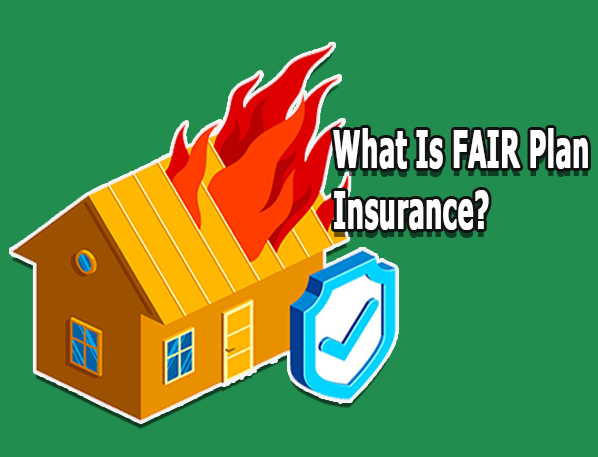From the perspective of traditional home insurance companies, not every house is in a location that is optimal for homeowners insurance. Homes in areas with a high risk of natural disasters are frequently deemed uninsurable by them. In certain states, homeowners can depend on FAIR plan insurance to give them the coverage they require in this situation.

FAIR Plan Insurance, or Fair Access to Insurance Requirements, is a program that provides home insurance to high-risk homeowners. Generally, people who purchase insurance through a FAIR Plan are ineligible for coverage in the regular home insurance market. This is because their home is in a high-risk neighborhood or they have other issues that concern insurers.
How Does FAIR Plan Insurance Work
Private insurers operating in states with an FAIR plan contribute financially to those states’ FAIR plans. Additionally, all insurers share profits, losses, and expenses under the FAIR plan, corresponding to their market share in each state. Therefore, multiple insurers bear the cost of insuring high-risk homes.
Furthermore, FAIR plan insurance may be necessary in certain scenarios, including high-risk areas and those frequently affected by natural disasters.
- Being a resident of a high-crime area.
- Not keeping up with repairs and maintenance around the house.
- Submitting numerous claims to home insurance.
While many states, particularly those with a high frequency of severe weather, do not offer a FAIR Plan, some do. Thirty-three states and Washington, D.C. offer or plan to offer FAIR Plans to homeowners who are high-risk as of 2022, the most recent year for which data is available.
What Does FAIR Plan Insurance Cover
State-specific offerings differ, but generally speaking, homeowners can obtain dwelling coverage via a FAIR plan. Typically, insurance for extra structures and personal belongings is only offered as an add-on. Usually, no loss-of-use or liability coverage is provided.
Dwelling coverage
A common feature of home insurance is dwelling coverage, which covers claims about the physical structure of your house but not your possessions. Furthermore, this coverage frequently restricts damage to specific “named” perils like hail, wind, fire, smoke, or lightning. Installed fixtures and appliances with permanent attachments are typically covered. The primary insurance component of the FAIR plan is residential coverage.
Contents coverage
Contents coverage, also known as personal property coverage, is provided when personal belongings, like furniture and clothing, are destroyed or damaged in a natural disaster like a fire or tornado. Generally, FAIR plan policies provide for optional content coverage.
Liability insurance
Generally, FAIR plans do not include liability coverage. The liability section of a home insurance policy covers court costs and related property damage if you or a family member injures or damages another person’s property. Incidents involving pets are also covered.
How to Qualify for FAIR Plan Insurance
Being considered high-risk does not ensure that you will be covered by a FAIR plan. To be eligible, you also need to fulfill a few requirements. Property owners typically need to upgrade to lower the risk of theft, fire, or water damage. Upgrading plumbing and electrical systems, improving security, or repairing a roof are examples of improvements. If you don’t comply, the FAIR plan administrator has the right to deny coverage. States may have different definitions of applicants who qualify for the FAIR plan.
Among the potential additional needs are:
- Your home insurance coverage must have been denied by at least two insurance companies. (Some states may require a higher number of insurance denials.)
- There are no outstanding liens, assessments, fines, or taxes on the property.
- The property does not violate any building, housing, air pollution, sanitation, or other ordinances or rules.
- To see if you can get regular coverage in the voluntary market, reapply every two years.
Review the information for the state’s FAIR plan where the home is located to ensure you know exactly what you need to have and accomplish before applying, as not all states have the same requirements.
How Much Does FAIR Plan Insurance Cost
Conventional home insurance is usually less expensive than a FAIR plan insurance policy. The cost of premiums varies by state. The amount of coverage, the style of home construction, and the deductible amount are factors that affect the cost of a FAIR plan.
How to Get FAIR Plan Insurance
While each state has its procedures for obtaining an FAIR policy, homeowners should generally follow these procedures and supply the following information when applying for the policy. These might consist of:
- Locate a certified insurance agent or broker who can assist you in locating and submitting an application for a FAIR plan. Certain states might provide a direct application process with the state.
- Fill out a coverage application.
- Provide any necessary pictures of the house.
- Give the mortgage lender comprehensive details about the property.
- Finish the property assessment.
- Give the state any further forms or information that it requests. For example, in the state of New Jersey, homeowners who do not purchase an FAIR plan through an agency must submit a signed Direct Authorization Form. Certain states may require proof that you were turned down for coverage.
- A required minimum premium down payment. If necessary, each state could have a different amount. In Wisconsin, when a homeowner applies, they must pay 20% of the annual premium.
You should contact a certified insurance agent in your state to find a FAIR policy. Your current auto insurance provider is a great place to start. Additionally, another option is to contact your state’s insurance department, which should have a list of insurance companies that offer FAIR policies.

